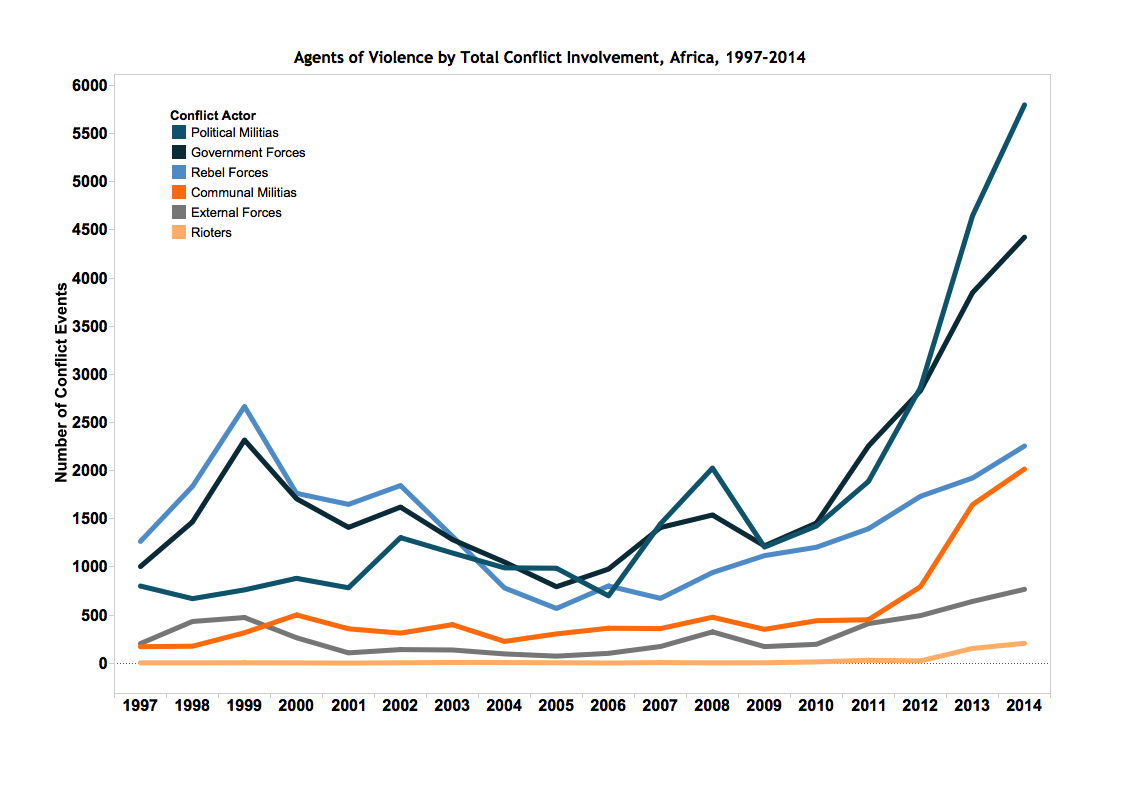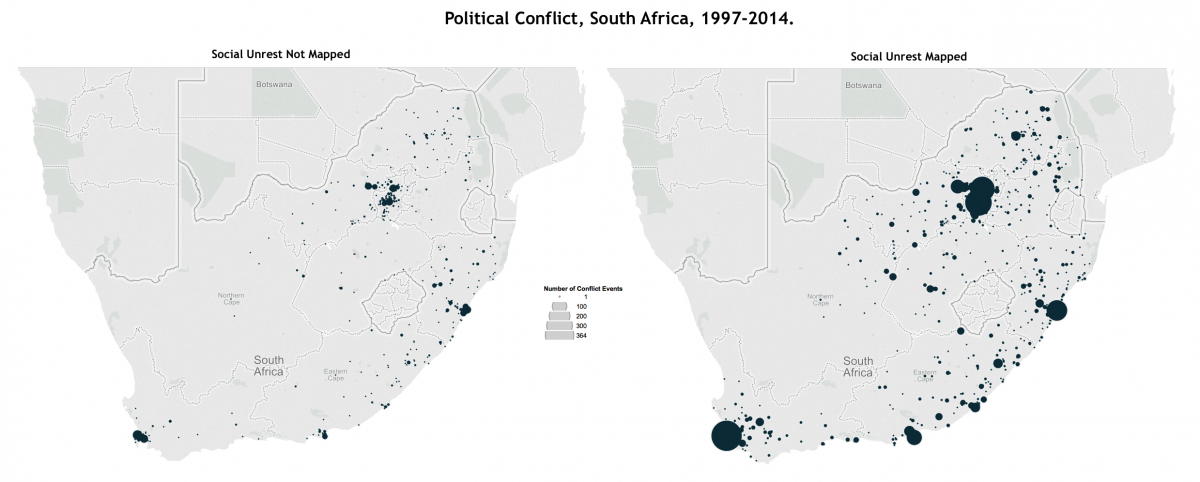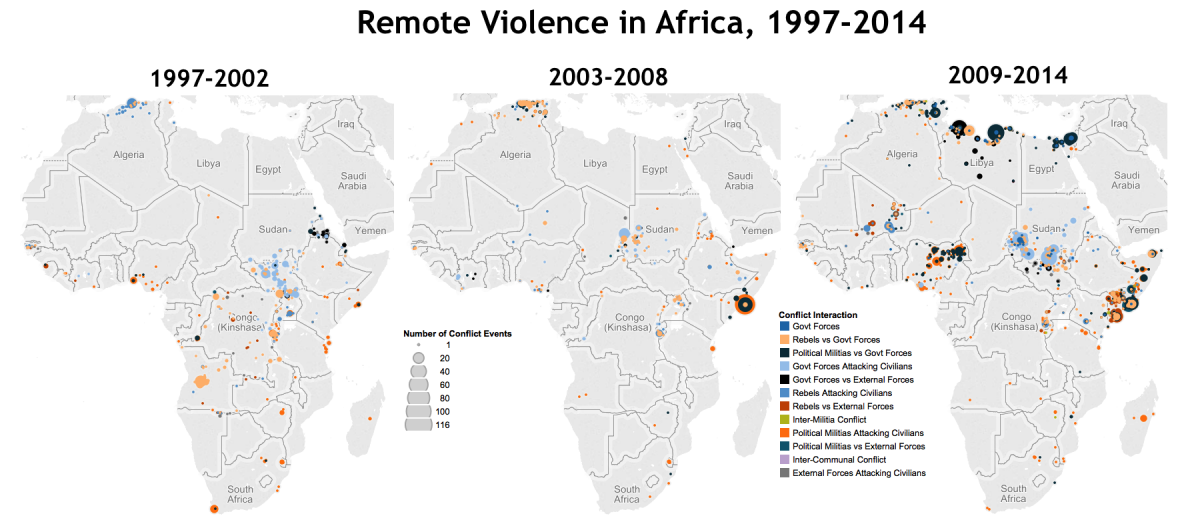The growth of pro-government political militias (PGMs) and unidentified armed groups (UAGs) has traditionally been associated with weak state capacity or attempts to minimize accountability. However, new research using advanced data mapping techniques suggests that the use of PGMs by the state is in fact a method of institutional management often implemented to uphold power structures, and should be seen as evidence of a strong state rather than a fragile one.

September 2015 ushered in a new global framework for international development. For the first time, the new Sustainable Development Goals (SDGs, 2016-2030) enshrine a commitment to significantly reducing global violence and conflict, a subject unaddressed by the Millennium Development Goals. Yet, despite ambitious objectives, it can be difficult to classify certain conflict events today in accordance with definitions of war, civil conflict and political violence that were defined years ago, and tricky to map changing dynamics over time as various agents, tactics, and strategies of conflict rise and fall. However, new data and analysis techniques have recently enabled researchers to observe previously unseen patterns, which have the potential to re-shape how we view modern warfare and conflict.
We focus on Sub-Saharan Africa, where intrastate conflict is now more common than the interstate conflicts more prevalent during the last century. Civil and transnational wars are decreasing, while domestic political instability continues to increase. Replacing rebel groups, in the past 10 years political militias have become responsible for over a third of all organized, armed conflict events on the continent, closely followed by government forces.
Political militias typically use violence as a means to shape and influence the existing political system, but do not seek to overthrow national regimes. They operate as ‘armed gangs’ for different political elites – including politicians, governments, and opposition groups. This change shows a move away from ‘exclusion-based violence’ – involving rebels and transnational conflict – to more ‘inclusion-based violence’ – involving governments and militias, especially pro-government militias.
Pro-government militias (PGMs) are informal violent organizations designed to perpetuate conflict for purposes that conform to regime agendas, and their existance can shed light on power struggles and competition within African institutions. “[Their] emergence and activities are crucial structures in governance practices across developing states, as they function to uphold power structures where internal competition among regime elites and politicians defines most conflict environments.” 1 The Janjaweed in Sudan are an example of a PGM. Internal feuds and mistrust within branches of government are often a more serious challenge than that posed by actors outside the regime, typically conceptualized as rebels or insurgents.2
In addition to the strategic use of militia violence by governments, there has also been a rise in conflict activity involving unidentified armed groups (UAGs). These groups can be used to carry out violence on behalf of a regime, especially in instances in which the state is dominant, yet wants to maintain legitimacy at home and on the international stage. For example, in Somalia remote violence and civilian targeting tend to occur in the same locations as battles, suggesting that the same/aligned actors may be involved.3,4

Here we explain how new data sources have enabled us to break down the myth that the fragile state is a benign entity onto which conflict occurs, rather than what is frequently the reality: the state (or a state-supporting militia) behaves as an armed actor contributing to the violence.
Mapping Conflict
The rapid global expansion in communications means that we have increasing access to new and more reliable sources of information on conflict. With more detailed information on conflict patterns, researchers and policy makers are better equipped to understand the relationship between governments, elites, and other institutions within society, and develop effective policy responses.
The Armed Conflict Location and Event Dataset (ACLED) is the most comprehensive public collection of political violence and protest data for developing states. It aggregates information on the specific dates and locations of political violence and protests, the types of events, the groups involved, fatalities, and changes in territorial control. Information is recorded on the battles, killings, riots, and recruitment activities of rebels, governments, militias, armed groups, protesters and civilians 5, and includes over 120,000 individual events.
ACLED data capture what is happening on the ground in conflict-affected states because its observations and methodology are designed to find previously obscured details on incidences of conflict. For example, it does not rely on a fatality threshold for the inclusion of conflict events in the dataset. When armed conflict is quantified using a measure of battle-related deaths, this creates multiple biases (e.g. towards larger conflicts, toward better reported violence, etc.). Most crucially, it creates a bias towards representing the experiences of men rather than women and girls, as men are the ones who tend to be killed on battlefields. Women and children, on the other hand, tend to be the victims of other types of violence during periods of conflict, such as sexual violence.
In addition to violent conflict, ACLED also includes nonviolent conflict events (e.g. protests) as these can and do often contribute to shaping conflict dynamics, and can also capture instability that may exist within a country that would otherwise not be accounted for. ACLED also records the actions of a variety of conflict actors including government forces, rebel groups, political militias, ethnic/communal militias, rioters, protesters, civilians, and external forces. By coding the various types of conflict, as well as the agents or actors of violence, a more complete understanding of the conflict landscape is possible. With real-time data updates, maps and reports, ACLED helps inform both researchers and humanitarian and development workers in crisis and conflict-affected contexts.
Challenging the Myth of the ‘Fragile State’
The observed growth in the conflict activities of political militias and UAGs in the ACELD data for Africa highlights the interconnectedness of state government and non-state armed actors. The prevailing view has been that regimes may rely upon pro-government militias (PGMs) as a result of weak state capacity (i.e. using PGMs to carry out violence in the spaces where the state lacks the ability to do so) or to minimize their accountability (i.e. using PGMs to conduct offenses that governments cannot / do not want to be deemed accountable for). However, new research suggests that state use of PGMs is, in fact, a method of institutional management. Often it is implemented to uphold power structures, and signals a strong state rather than a fragile one.6
The data increasingly shows that the state is often not a victim but an armed actor contributing to violence, illustrated by the fact that state forces are able to make use of repression tactics in order to maintain their position of authority through the use of PGMs. In such cases, the presence of violence does not signal the fragility or weakness of a state regime, but rather the opposite. In other words, the presence of political violence is not indicative of fragility and may even point to a flaw or limitation in the utility of the fragility framework in development.
This is important because by labeling states as fragile, the international donor community creates socially and politically constructed concepts that may address merely the symptoms of fragility rather than the causes, reducing the opportunity for alternative and deeper analysis into the roots of violence.7 A key example is the widespread use of the label ‘security threat’ to define citizen risk during conflict or political violence, whereby citizens are assumed to be part of one homogenous group with the same interpretation of security as the state in control. This is not a realistic picture of state-society relations in many oppressive regimes where political violence is dominant and state forces are an active agent of violence, often playing societal groups off one another to further destabilize conditions.
There has also been a rise in demonstrations, especially revolt and reform protests, in Africa relative to average levels a decade ago. For example, a more peaceful picture of South Africa emerges when the high number of protests that occur there are not collected and recorded, while a relatively low(er) number of violent conflict events is noted.

The use of unarmed/non-violent conflict in expressions of dissent and attempts to seek institutional change are also especially prevalent in South and Southeast Asia. Regional comparisons can be instructive. Recent trends suggest that rioting and protesting are used in Asian states in order to engage in political change, whereas in African states this type of change is often sought through the use of militia groups. Studies of rioting in India 8 suggest that political elites encourage this form of ‘mob’ politics as a way to demonstrate their strength and ‘value’; and the same logic applies to political militia behavior across African states.9 The use of alternative forms suggests potentially different underlying incentives in the institutional structures of South/Southeast Asian and African states.10
The techniques and strategies of violence are also changing. Evidence of this includes a recent spike in the use of remote violence tactics, especially across the African continent. Improvised Explosive Devices (IEDs) function well as symbolic weapons; “by targeting agents of the state, civilians, popular monuments or symbols, IEDs can be used to undermine confidence in the government and coerce public opinion and government policies11”.12 This type of violence can be used to expose a regime’s vulnerability to violence, or a government’s inability to protect its citizens.13 For non-state actors such as political militias that are typically weaker than government forces, remote violence is an ideal tactic to either damage state forces with minimal risk, or to coerce the state without controlling it. This has been observed in numerous settings, including Afghanistan.14

It is clear that security threats are not uniform across countries but specific to a time, a place, and social groups. Thus, more closely examining current conflict patterns can provide local and disaggregated information on discrete and often small-scale violence. This information could serve as an early warning signal for a violent uprising, and help policymakers better predict incidences, potential victims and areas of fragility.
What Is Needed to Achieve SDG 16?
Looking at the broader picture, it is notable that SDG 16 emphasizes a link between effective, accountable, and inclusive institutions and peace, calling on the international development community to “promote peaceful and inclusive societies for sustainable development, provide access to justice for all and build effective, accountable and inclusive institutions at all levels”15. For institutions to be effective, we argue, they must have information to understand risks and plan security for all civilians. Achieving this goal (and the broader development objectives of the SDGs) will require a greater understanding of the linkages between conflict actors, institutions, and state-society relations that go beyond the dominant ‘fragility’ framework.
A recent study16 found that only 3.1% of conflict studies included local-level empirical data, meaning that what policymakers are currently reading (and even commissioning) may not rest on a firm evidence base. This is the result of both a supply and a demand-side challenge. On the supply side, researchers must strive to access detailed, current data, and to conduct and communicate the most relevant research. On the demand side, barriers to consumption of research by policymakers include lack of awareness of the importance of an evidence base, anti-intellectualism arising from a fear of criticism or pressure to produce fast results, and a lack of institutional capacity to absorb research and politicization of research.17 Despite these challenges, there are a number of promising networks springing up around the world to help overcome barriers and build the capacity of governments to make informed decisions using data.18 Examples include The African Evidence Network19 and the Informed Humanitarian.20
Researchers and policy makers alike must now dig deeper, and re-commit to understanding and addressing conflict, in order to create more peaceful and inclusive societies for the SDG period of sustainable development.











